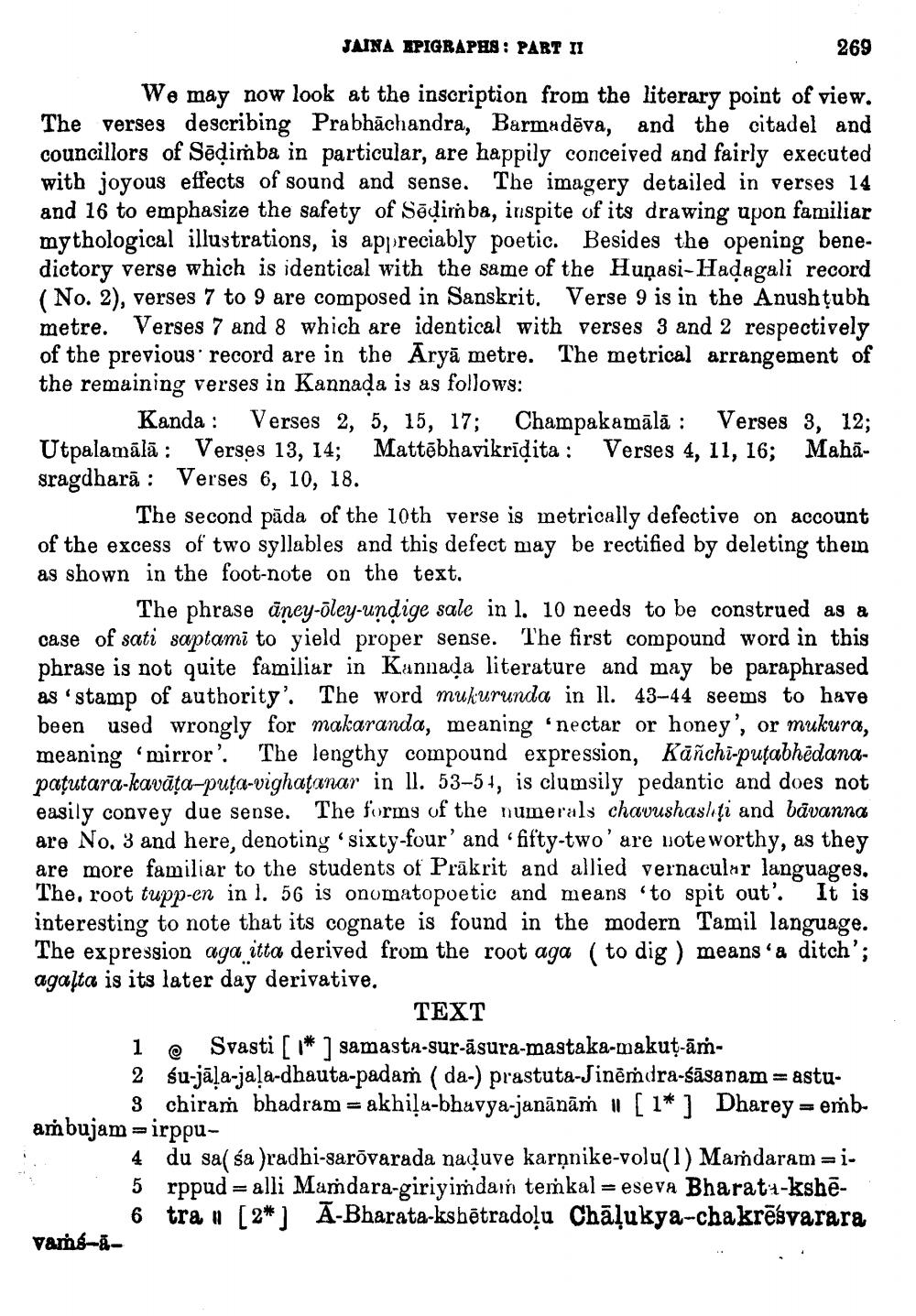________________
JAINA APIGRAPHS : PART II
269 We may now look at the inscription from the literary point of view. The verses describing Prabhāchandra, Barmadēva, and the citadel and councillors of Sēdimba in particular, are happily conceived and fairly executed with joyous effects of sound and sense. The imagery detailed in verses 14 and 16 to emphasize the safety of Sõdimba, inspite of its drawing upon familiar mythological illustrations, is appreciably poetic. Besides the opening benedictory verse which is identical with the same of the Huñasi-Hadagali record (No. 2), verses 7 to 9 are composed in Sanskrit. Verse 9 is in the Anushțubh metre. Verses 7 and 8 which are identical with verses 3 and 2 respectively of the previous record are in the Aryā metre. The metrical arrangement of the remaining verses in Kannada is as follows:
Kanda: Verses 2, 5, 15, 17; Champakamālā : Verses 3, 12; Utpalamālā : Verses 13, 14; Mattēbhavikrīļita : Verses 4, 11, 16; Mahāsragdharā : Verses 6, 10, 18.
The second pāda of the 10th verse is metrically defective on account of the excess of two syllables and this defect may be rectified by deleting them as shown in the foot-note on the text.
The phrase āney-āley-undige sale in l. 10 needs to be construed as a case of sati saptami to yield proper sense. The first compound word in this phrase is not quite familiar in Kannada literature and may be paraphrased as 'stamp of authority'. The word mukurunda in 11. 43-44 seems to have been used wrongly for makaranda, meaning 'nectar or honey', or mukura, meaning 'mirror? The lengthy compound expression, Kāñchi-puţabhedanapatutara-kavāța-puta-vighatanar in ll. 53–54, is clumsily pedantic and does not easily convey due sense. The forms of the numerals chavushashţi and bāvanna are No. 3 and here, denoting sixty-four' and 'fifty-two' are voteworthy, as they are more familiar to the students of Prākrit and allied vernacular languages. The, root tupp-en in l. 56 is onomatopoetic and means 'to spit out'. It is interesting to note that its cognate is found in the modern Tamil language. The expression aga itta derived from the root aga (to dig) means'a ditch'; agasta is its later day derivative.
TEXT i Svasti [1* 1 samasta-sur-āsura-mastaka-makut-ām2 su-jāla-jala-dhauta-padam (da-) prastuta-Jinêmdra-śāsanam = astu
3 chiram bhadram = akhila-bhavya-janānāṁ [1* ] Dharey-embambujam - irppu
4 du sal sa Jradhi-sarovarada naduve karạnike-volu(1) Maņdaram=i. 5 rppud = alli Mandara-giriyimdam temkal = eseva Bharat 2-kshē
6 tra o [2* ] A-Bharata-ksbētradoļu Chāļukya-chakrēsvarara vams--




